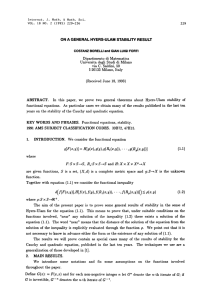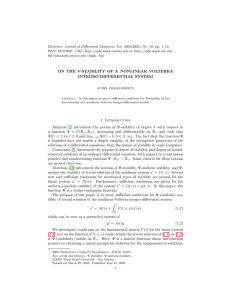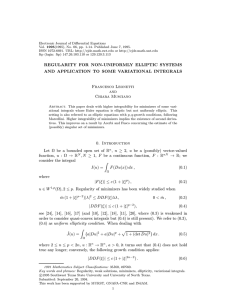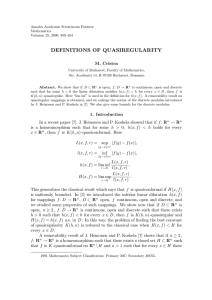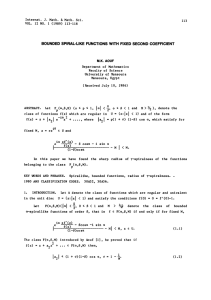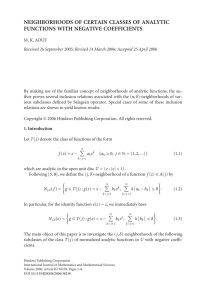Electronic Journal of Differential Equations, Vol. 2010(2010), No. 152, pp.... ISSN: 1072-6691. URL: or
advertisement
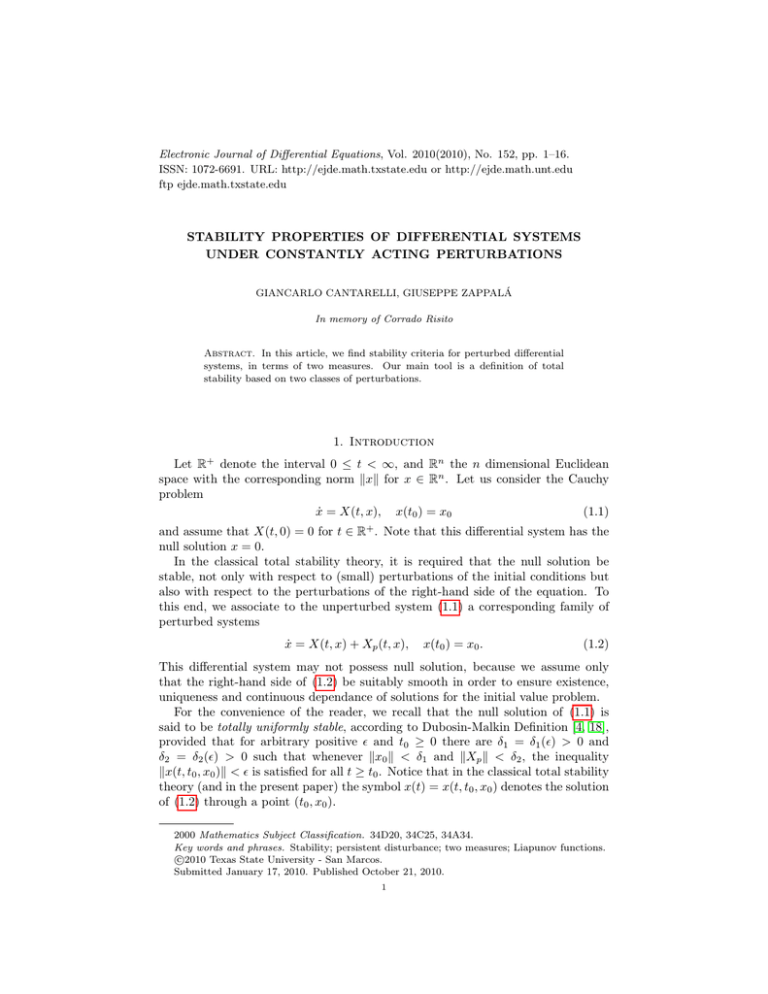
Electronic Journal of Differential Equations, Vol. 2010(2010), No. 152, pp. 1–16.
ISSN: 1072-6691. URL: http://ejde.math.txstate.edu or http://ejde.math.unt.edu
ftp ejde.math.txstate.edu
STABILITY PROPERTIES OF DIFFERENTIAL SYSTEMS
UNDER CONSTANTLY ACTING PERTURBATIONS
GIANCARLO CANTARELLI, GIUSEPPE ZAPPALÁ
In memory of Corrado Risito
Abstract. In this article, we find stability criteria for perturbed differential
systems, in terms of two measures. Our main tool is a definition of total
stability based on two classes of perturbations.
1. Introduction
Let R+ denote the interval 0 ≤ t < ∞, and Rn the n dimensional Euclidean
space with the corresponding norm kxk for x ∈ Rn . Let us consider the Cauchy
problem
ẋ = X(t, x), x(t0 ) = x0
(1.1)
and assume that X(t, 0) = 0 for t ∈ R+ . Note that this differential system has the
null solution x = 0.
In the classical total stability theory, it is required that the null solution be
stable, not only with respect to (small) perturbations of the initial conditions but
also with respect to the perturbations of the right-hand side of the equation. To
this end, we associate to the unperturbed system (1.1) a corresponding family of
perturbed systems
ẋ = X(t, x) + Xp (t, x),
x(t0 ) = x0 .
(1.2)
This differential system may not possess null solution, because we assume only
that the right-hand side of (1.2) be suitably smooth in order to ensure existence,
uniqueness and continuous dependance of solutions for the initial value problem.
For the convenience of the reader, we recall that the null solution of (1.1) is
said to be totally uniformly stable, according to Dubosin-Malkin Definition [4, 18],
provided that for arbitrary positive and t0 ≥ 0 there are δ1 = δ1 () > 0 and
δ2 = δ2 () > 0 such that whenever kx0 k < δ1 and kXp k < δ2 , the inequality
kx(t, t0 , x0 )k < is satisfied for all t ≥ t0 . Notice that in the classical total stability
theory (and in the present paper) the symbol x(t) = x(t, t0 , x0 ) denotes the solution
of (1.2) through a point (t0 , x0 ).
2000 Mathematics Subject Classification. 34D20, 34C25, 34A34.
Key words and phrases. Stability; persistent disturbance; two measures; Liapunov functions.
c
2010
Texas State University - San Marcos.
Submitted January 17, 2010. Published October 21, 2010.
1
2
G. CANTARELLI, G. ZAPPALÁ
EJDE-2010/152
We emphasize that our stability criteria in Section 3 generalize two well-known
Malkin theorems. In fact, a Malkin theorem [12, 18] on the total uniform stability
is included as a special case in Theorem 3.1, while Theorem 3.6 improves another
Malkin theorem [13, 18]. There under appropriate hypotheses Malkin proves that
For arbitrary positive and t0 ≥ 0, there are δ1 = δ1 () > 0 and
δ2 = δ2 () > 0 and for any η ∈]0, [ there is δ3 (η) ∈]0, δ2 ] such that
whenever kx0 k < δ1 and kXp k < δ3 there exists a constant Tη > 0,
such that kx(t, t0 , x0 )k < is satisfied for all t ≥ t0 + Tη .
It is worth noting that this property first comes the concept of the strong stability
under perturbations in generalized dynamical systems introduced by Seibert [21].
The aim of the present article is to introduce and study a new type of total
stability in terms of two measures, by splitting the perturbation terms Xp in two
parts. Namely, by putting Xp = Y + Z. In Sections 3,4, 5, we require the usual
upper restriction on the Euclidean norm of vector Z, while we select vector Y by
an appropriate scalar product. In Section 6, a mechanical example illustrates our
theoretical results.
2. Preliminaries, notation and basic ideas
Let K := {a : R+ → R+ : continuous, strictly increasing, a(0) = 0} be the set of
functions of class K in the sense of Hahn. We shall define some concepts in terms
of two measures [8, 9, 15]. Namely, we denote by h(t, x) and h0 (t, x) two continuous
scalar functions satisfying the conditions:
(i) inf x h0 (t, x) = 0 for every t ∈ R;
(ii) there exists a positive constant λ and a function m = m(u) ∈ K such that
h0 (t, x) < λ implies h(t, x) ≤ m[h0 (t, x)] < m(λ).
In mathematical language, condition (ii) means that h0 is uniformly finer than
h, and it implies that inf x h(t, x) = 0 for every t ∈ R.
Putting Q(s) = {(t, x) ∈ R+ × Rn : 0 < h(t, x) ≤ s}, we observe that 0 < s0 < s
implies Q(s0 ) ⊆ Q(s), and moreover the intersection ∩Q(s) for all s > 0 is the
empty set. Hence, the set of the sets {Q(s)} represents a Cartan-Silov direction or,
simply, a direction.
The above theoretical concepts are essential in the following definition: For every
scalar V = V (t, x) we say that limh→0 V (t, x) = 0 if and only if for every direction
such that lim h(t, x) = 0, we have lim V (t, x) = 0, see [22].
Denote by U = U (t, x) and G = G(t, x) respectively a continuous scalar function
and a continuous n-vector function such that kGk > 0 on R+ × Rn . For the
unperturbed differential system
ẋ = X(t, x),
x(t0 ) = x0
(2.1)
and a correspondent perturbed differential system
ẋ = X(t, x) + Y (t, x) + Z(t, x) x(t0 ) = x0
(2.2)
without further mention, we will assume that Y G ≤ U , where Y G denotes the
scalar product of the vectors Y and G. Moreover, we assume that the right-hand
sides of (2.1) and (2.2), are L-measurable in t ∈ R+ , continuous in x ∈ Rn . Also
we assume that for every compact subset A ⊂ Rn there exists a map σA = σA (t)
locally integrable such that kX(t, x)k, kY (t, x)k, kZ(t, x)k < σA (t) when x ∈ A.
EJDE-2010/152
STABILITY PROPERTIES
3
The previous conditions (Caratheodory’s conditions) ensure the existence and
the general continuity of solutions for (2.1) and (2.2); see [2, 3]. Then, for every
(t0 , x0 ) ∈ R+ × Rn we denote by x(t) = x(t, t0 , x0 ) a solution of (2.2), and we
assume that x(t) is defined for t ≥ t0 .
For every continuous scalar function V = V (t, x) having continuous partial
derivatives we put
∂V
∂V
Vt =
, Vx = grad V =
, V̇1 = Vt + Vx · X = V̇ .
(2.3)
∂t
∂x
The function V̇ is said to be the derivative of V computed along the solutions of
the unperturbed system (2.1). While the related formula given by Malkin [12, 18],
V̇2 (t, x) = V̇ (t, x) + Vx (t, x)[Y (t, x) + Z(t, x)]
(2.4)
gives the derivative of V along the solutions of the perturbed system (2.2).
If φ and θ are two scalar functions, it easy to prove the following results which
will be used in the next sections.
(i) if Vx = φG and Y G ≤ U , when φ > 0 we deduce
V̇2 (t, x) = V̇ (t, x) + φ(t, x)[GY (t, x) + GZ(t, x)],
(2.5)
V̇2 (t, x) ≤ V̇ (t, x) + φ(t, x)[U (t, x) + kG(t, x)kkZ(t, x)k];
(2.6)
(ii) if U (t, x) ≤ 0 and φ(t, x) > 0, Vx = φG we deduce
V̇2 (t, x) ≤ V̇ (t, x) + φ(t, x)kG(t, x)kkZ(t, x)k;
(2.7)
(iii) if U (t, x) ≥ 0, φ(t, x) > 0, θ(t, x) > 0, Vx (t, x) = φG(t, x) and V̇ (t, x) ≤
−θU (t, x), we deduce
V̇2 (t, x) ≤ −[θ(t, x) − φ(t, x)]U (t, x) + φ(t, x)kG(t, x)kkZ(t, x)k.
(2.8)
We conclude the present section with a list of definitions concerning the several
kinds of the stability in terms of two measures and two perturbations.
Definition 2.1. System (2.1) is said to be (h0 , h)-stable under two persistent perturbations, also called (h0 , h)-t.bistable, if for every t0 ∈ R+ and every > 0, there
exist a number δ1 = δ1 (t0 , ) and a function δ2 = δ2 (t0 , x, ) > 0 such that for
all x0 ∈ Rn with h0 (t0 , x0 ) < δ1 , all Z(t, x) with kZ(t, x)k < δ2 , and all Y with
Y G ≤ U ; we have h[t, x(t)] < when t ≥ t0 .
If δ1 = δ1 () and δ2 = δ2 () are independent of t0 and x, we have the uniformity.
Definition 2.2. System (2.1) is said to be strongly weakly (h0 , h)-t.bistable, if in
Definition 2.1, δ2 (t0 , x, ) ≥ 0, and the L-measure of set
Et (δ2 = 0) = {x ∈ Rn : δ2 (t0 , x, ) = 0}
(2.9)
+
is zero for t0 ∈ R and > 0.
In the following we will briefly write δ2 ∈ GG to indicate this condition.
Definition 2.3. System (2.1) is said to be weakly (h0 , h) − t.bistable if, for every
t0 ∈ R+ and > 0, there exists at the most one x ∈ Rn such that δ2 (t0 , x, ) = 0.
In the following this condition will be briefly denoted as δ2 ∈ ZZ.
Definition 2.4. System (2.1) is said to be (h0 , h)-eventually stable under two persistent perturbations, also called eventually (h0 , h)-t.bistable, if: For every > 0
there exists T = T () > 0, for every t0 ≥ T there exist δ1 = δ1 (t0 , ) and
4
G. CANTARELLI, G. ZAPPALÁ
EJDE-2010/152
δ2 = δ2 (t0 , x, ) > 0 such that for every x0 ∈ Rn with h0 (t0 , x0 ) < δ1 , for every Z with kZ(t, x)k < δ2 and every Y with Y G ≤ U , we have h[t, x(t)] < when
t ≥ t0 .
Definition 2.5. System (2.1) is said to be (h0 , h)-semiattractive, if it is (h0 , h)t.bistable and: For every η ∈]0, [ there exists a function δ3 > 0, with 0 < δ 3 ≤ δ2 ,
such that for every Z : kZk < δ3 and every Y with Y G ≤ U , there exists Tη > 0
for which h[t, x(t)] < η when t ≥ t0 + Tη , where x(t) = x(t, t0 , x0 ) is a solution of
(2.2).
Definition 2.6. System (2.1) is said to be (h0 , h)-stable on average under two
persistent perturbation, also called (h0 , h)-t.bistable on average, if: For every t0 ∈
R+ , every > 0 and every T > 0, there exist δ1 and δ2 > 0 such that every solution
x(t) = x(t, t0 , x0 ) of (2.2) with h0 (t0 , x0 ) < δ1 , Y G ≤ U , and
Z t+T
sup{kZ(u, x)k : x ∈ Rn }du < δ2 ∀t ≥ t0
(2.10)
t
satisfies h[t, x(t)] < for all t ≥ t0 .
3. Theoretical developments
Suppose that the functions X, G, U are the known start point. We will use the
technique that is known as family of Liapunov functions introduced by Salvadori
[20]. The basic advantage of this method is that the single function needs to satisfy
less rigid requirements than in other methods.
Theorem 3.1. Let U : R+ × Rn → R be given. Assume that for every > 0, there
exist three scalar functions Θ = Θ(t, x), φ = φ(t, x) ∈ C, and V = V (t, x) ∈ C 1 ,
and exists a constant l such that on the set R+ × Rn we have:
(i) h(t, x) = implies V (t, x) ≥ l > 0;
(ii) limh→0 V (t, x) = 0;
(iii) Θ(t, x) > φ(t, x) > 0 and (Θ − φ)U > 0;
(iv) Vx (t, x) = φG(t, x);
(v) V̇ (t, x) ≤ −ΘU (t, x).
Then system (2.1) is (h0 , h)-t.bistable.
Proof. Given t0 , , l, Θ, φ, V , by (ii) there exists d > 0 such that h(t0 , x) < d implies
V (t0 , x) < l. If we select x0 ∈ Rn such that h0 (t0 , x0 ) < δ1 = min[λ, m−1 (d)] for
the previous assumptions we recognize that h(t0 , x0 ) < m[h0 (t0 , x0 )] < d, hence
V (t0 , x0 ) < l. From the Malkin formula (2.4), according to (iv) and (v), we deduce
V̇2 (t, x) ≤ −(Θ − φ)U (t, x) + φkG(t, x)kkZ(t, x)k.
Then by selecting
kZ(t, x)k ≤
(3.1)
(Θ − φ)U (t, x)
= δ2 (t, x, )
kφG(t, x)k
it follows that V̇2 (t, x) ≤ 0.
Consider a solution x(t) = x(t, t0 , x0 ) of the perturbed system and the correspondent functions h1 (t) = h[t, x(t)], V1 (t) = V [t, x(t)]. If there exists t0 > t0 such
that h1 (t0 ) = with h1 (t) < for t ∈ [t0 , t0 [ then we should deduce that V1 (t0 ) ≥ l,
which is a contradiction.
EJDE-2010/152
STABILITY PROPERTIES
5
Remark. If U ≥ 0 the system can be strongly weakly (h0 , h)-t.bistable or weakly
(h0 , h)-t.bistable.
Corollary 3.2. Suppose that there exist three scalar functions Θ = Θ(t, x), φ =
φ(t, x) ∈ C and V = V (t, x) ∈ C 1 such that on R+ × Rn we have:
(i) for each > 0 there exists l > 0 such that h(t, x) = implies V (t, x) ≥ l > 0;
(ii) limh→0 V (t, x) = 0;
(iii) Θ(t, x) > φ(t, x) > 0 and (Θ − φ)U > 0;
(iv) Vx (t, x) = φG(t, x);
(v) V̇ (t, x) ≤ −ΘU (t, x).
Then (2.1) is (h0 , h)-t.bistable.
Corollary 3.3. For a scalar function U < 0, suppose that there exist three scalar
functions L = L(t, x), φ = 1, V = V (t, x) such that the conditions (i)–(iv) in Corollary 3.2 hold, and that V̇ (t, x) ≤ −L(t, x) < 0. Then (2.1) is (h0 , h)−t.bistable.
Proof. From (2.7) we have
V̇2 (t, x) ≤ −L(t, x) + kGkkZk
hence by choosing kZk ≤ L/kGk we have the proof.
(3.2)
Theorem 3.4. Suppose that for every > 0 there exist two scalar functions φ =
φ(t, x), Θ = Θ(t, x) ∈ C, a map N = N (u) L-measurable, the scalar function
V = V (t, x) ∈ C 1 , and a constant l such that on R+ × Rn we have:
(i) h(t, x) = implies V (t, x) ≥ l > 0;
(ii) limh→0 V (t, x) = 0;
R +∞
(iii) V̇ (t, x) ≤ −ΘU (t, x) + N (t) with 0 < 0 N (u)du < +∞ and U > 0 (a
hypothesis of Hatvani’s type);
(iv) Θ(t, x) ≥ φ(t, x) > 0 and (Θ − φ)U > 0;
(v) Vx (t, x) = φG(t, x).
Then (2.1) is eventually (h0 , h)-t.bistable.
Proof. Given > 0 we consider the function
Z +∞
W (t, x) = V (t, x) +
N (u)du
(t > 0).
(3.3)
t
R +∞
Let T > 0 such that 2 t0 N (u)du < l for t0 ≥ T , and let d > 0 such that h(t0 , x) <
d implies (by (ii)) 2V (t0 , x) < l. If x0 ∈ Rn and h0 (t0 , x0 ) < δ1 = min[λ, m−1 (d)],
we deduce that h(t0 , x0 ) ≤ m[h0 (t0 , x0 )] < d and 2V (t0 , x0 ) < l. Then it follows
that W (t0 , x0 ) < l. Consider the derivatives
Ẇ (t, x) = V̇ (t, x) − N (t) ≤ −ΘU (t, x) < 0,
(3.4)
Ẇ2 (t, x) ≤ −(Θ − φ)U (t, x) + φkG(t, x)kkZ(t, x)k.
(3.5)
Provided that
kZ(t, x)k ≤
(Θ − φ)U (t, x))
= δ2 (t, x, )
φkG(t, x)k
(3.6)
we obtain Ẇ2 (t, x) ≤ 0. Selecting Z = Z(t, x) such that kZ(t, x)k ≤ δ2 , consider
x(t) = x(t, t0 , x0 ) a solution of the perturbed system (2.2), and put H(t) = h[t, x(t)],
v(t) = V [t, x(t)], w(t) = W [t, x(t)]. Suppose that there exists t0 > t0 such that
6
G. CANTARELLI, G. ZAPPALÁ
EJDE-2010/152
H(t0 ) = and H(t) < for t0 ≤ t < t0 . So we have v(t0 ) > l hence w(t0 ) > l. This
is a contradiction which completes the proof.
Lemma 3.5. Suppose that there exist four scalar functions φ = φ(t, x), U =
U (t, x), Θ = Θ(t, x) ∈ C, V = V (t, x) ∈ C 1 , a scalar function Ψ = Ψ(t, h) Lintegrable with respect to t ∈ R+ , a map a = a(u) ∈ K such that on R+ × Rn , we
have
(i) V (t, x) ≥ a[h(t, x)];
(ii) limh→0 V (t, x) = 0;
(iii) Vx (t, x) = φG(t, x);
(iv) V̇ (t, x) ≤ −ΘU (t, x) < 0;
(v) Θ(t, x) > φ(t, x) > 0 and (Θ − φ)U > 0;
(vi) (Θ − φ)U (t, x) = Ψ[t, h(t, x)];
(vii) Ψ(t, h) ≥ Ψ(t, µ) when h ≥ µ > 0;
R +∞
(viii) t0 Ψ(τ, ρ)dτ = +∞, for all t0 ∈ I, all ρ > 0.
Then (2.1) is (h0 , h)-t.bistable. Also for every > 0, for every η ∈]0, ], for each
γ > 0 for every t0 ∈ R+ and x0 ∈ Rn with h0 (t0 , x0 ) < δ1 , for every Z with
1 (Θ − φ)U (t, x)
= δ3 ;
(3.7)
kZ(t, x)k ≤
1+γ
φkG(t, x)k
there exists tη ≥ t0 for which h[tη , x(tη )] < η where x = x(t, t0 , x0 ) is solution of
(2.2).
Proof. By contradiction let us assume that that there exist 1 > 0, η1 ∈]0, 1 ],
(t1 , x1 ) ∈ R+ × Rn : h0 (t1 , x1 ) < δ1 , γ1 > 0, Z1 : kZ1 (t, x)k < δ3 (depending on
γ1 ) such that h[t, x1 (t)] ≥ η1 when t ≥ t1 where x1 (t) = x(t, t1 , x1 ) is obviously a
solution of (2.2).
Consider the derivative V̇2 (t, x): by hypotheses (iii) and (iv) we have
V̇2 (t, x) = V̇ + φGY (t, x) + φGZ(t, x) ≤ −(Θ − φ)U + φkGkkZk
(3.8)
Thus selecting
kZ(t, x)k ≤
1 (Θ − φ)U (t, x)
1
=
δ2 = δ3
1 + γ1 φkG(t, x)k
1 + γ1
(3.9)
γ1
(Θ − φ)U < 0.
1 + γ1
(3.10)
we obtain
V̇2 (t, x) ≤ −
hence by (vi)
γ1
Ψ[t, h(t, x)].
(3.11)
1 + γ1
On the set {(t, x) ∈ R+ × Rn : h(t, x) ≥ η1 > 0} we have Ψ[t, h(t, x)] ≥ Ψ(t, η1 ) and
V̇2 (t, x) ≤ −
γ1
Ψ(t, η1 ).
1 + γ1
Along the above solution x1 (t) we obtain, for t ≥ t1 ,
Z t
Z t
γ1
V̇2 [u, x1 (u)]du ≤ −
Ψ(u, η1 )du,
1 + γ1 t1
t1
Z t
γ1
Ψ(u, η1 )du
V [t, x1 (t)] ≤ V (t1 , x1 ) −
1 + γ1 t1
V̇2 (t, x) ≤ −
which is a contradiction.
(3.12)
(3.13)
(3.14)
EJDE-2010/152
STABILITY PROPERTIES
7
Theorem 3.6. Under the hypotheses of Lemma 3.5 suppose that
(ix) There exist b = b(u) ∈ K such that b[h0 (t, x)] ≤ h(t, x) on R+ × Rn .
Then, for every > 0 and σ ∈]0, ], there exists a function δ3 = δ3 (t, x, σ) ∈]0, δ2 ]
such that: for every t0 ∈ R+ , for every x0 ∈ Rn with h0 (t0 , x0 ) < δ1 , and for every
Z : kZ(t, x)k < δ3 ; there exists Tσ > 0 for which h[t, x(t)] < σ when t ≥ t0 + Tσ
where x(t) = x(t, t0 , x0 ) is a solution of (2.2).
Proof. Since the system (2.1) is (h0 , h)-t.bistable, given t0 ∈ R+ and > 0 there
exist δ1 = δ1 (t0 , ) and δ2 = δ2 (t, x, ) > 0 such that fixed x0 ∈ Rn for which
h0 (t0 , x0 ) < δ1 and select Z : kZ(t, x)k < δ2 we have h[t, x(t)] < for t ≥ t0 where
x(t) = x(t, t0 , x0 ) is a solution of (2.2).
It is obvious that for every σ ∈]0, [ there exist d1 ∈]0, δ1 [ and d2 ∈]0, δ2 [ such
that fixed (t1 , x1 ) ∈ R+ × Rn for which h0 (t1 , x1 ) < d1 , select Z : kZ(t, x)k < d2
we have h[t, x1 (t)] < σ for t ≥ t1 where x1 (t) = x1 (t, t1 , x1 ) is a solution of (2.2).
From Lemma 3.5, given η ∈]0, σ[⊂]0, ] there exists d3 ∈]0, d2 [ such that for
every Z : kZ(t, x)k ≤ d3 there exists tη ≥ t0 for which h[tη , x(tη )] < η where
x(t) = x(t, t0 , x0 ) is a solution of (2.2).
If we assume that η = b(d1 ), we obtain
b{h0 [tη , x(tη )]} ≤ h[tη , x(tη )] < η = b(d1 );
(3.15)
i.e., h0 [tη , x(tη )] < d1 . Hence when kZ(t, x)k ≤ d3 we have h[t, x(t)] ≤ σ for t ≥ tη .
Putting Tη = tη − t0 we then obtain the semiattractivity.
Theorem 3.7. Suppose that there exist three functions from R × Rn to R: U =
U (t, x), φ = φ(t, x) ∈ C, V = V (t, x) ∈ C 1 ; three functions a = a(u), b = b(u),
c = c(u) belonging to K; and a constant N > 0; such that on R+ × Rn , we have:
(i)
(ii)
(iii)
(iv)
(v)
a[h(t, x)] ≤ V (t, x) ≤ b[h(t, x)];
φ(t, x) > 0;
Vx (t, x) = φG(t, x), kVx (t, x)k < N ;
V̇ (t, x) ≤ −c[h(t, x)];
given r, T, > 0, put ν = Tr : the condition ν < h(t, x) < implies
φU (t,x)
c(ν)
V (t,x) < 2b() .
Then (2.1) is (h0 , h)-t.bistable on average.
Proof. Given t0 ∈ R+ , and T > 0, from (i) h(t, x) = implies V (t, x) ≥ a().
Select d ∈]0, [ such that:
(i) h(t0 , x) < d implies V (t0 , x) < a();
(ii) b(d) < 21 a().
If x0 ∈ Rn : h0 (t0 , x0 ) < δ1 = min[λ, m−1 (d)] we have h(t0 , x0 ) ≤ m[h0 (t0 , x0 )] ≤
d hence V (t0 , x0 ) < a(). Let x(t) = x(t, t0 , x0 ) be a solution of (2.2) and suppose
that there exist t0 , t00 ∈ R+ with the following properties:
(iii) t0 ≤ t0 < t00 ;
(iv) h(t00 , x00 ) = h[t00 , x(t00 )] = ;
(v) h(t0 , x0 ) = h[t0 , x(t0 )] = min h[t, x(t)] and h(t0 , x0 ) ≤ h[t, x(t)] ≤ h(t00 , x00 ) on
t0 ≤ t ≤ t00 .
8
G. CANTARELLI, G. ZAPPALÁ
EJDE-2010/152
Put W (t, x) = V (t, x)eβ(t) , where β = β(t) : R+ → R is a scalar function that
will be defined in (3.23), and consider the derivatives
Ẇ1 (t, x) = Ẇ (t, x) = V̇ (t, x)eβ(t) + V (t, x)eβ(t) β̇(t),
(3.16)
Ẇ2 (t, x) = Ẇ (t, x) + Wx [Y (t, x) + Z(t, x)],
Ẇ2 (t, x) = V̇ (t, x)eβ(t) + V (t, x)eβ(t) β̇(t) + eβ(t) [Vx Y (t, x) + Vx Z(t, x)],
h V̇ (t, x)
Vx Y (t, x) Vx Z(t, x) i
Ẇ2 (t, x) = W (t, x)
(3.17)
+ β̇(t) +
+
V (t, x)
V (t, x)
V (t, x)
if we select Y (t, x) such that Vx Y ≤ U we obtain
n V̇ (t, x)
o
φU (t, x) kVx (t, x)k
Ẇ2 (t, x) ≤ W (t, x)
+ β̇(t) +
+
kZ(t, x)k .
V (t, x)
V (t, x)
V (t, x)
On the set
{A} = {(t, x) ∈ R+ × Rn : d =
(3.18)
r
< h(t, x) < }
T
for suitable r ∈]0, T [ we have
(s)
V̇ (t, x)
c(d)
<−
;
V (t, x)
b()
(ss)
φU (t, x)
c(d)
<
V (t, x)
2b()
(3.19)
hence
c(d)
N
Ẇ2 (t, x) ≤ W (t, x) β̇(t) −
+
kZ(t, x)k .
(3.20)
2b() a(d)
Fixed t ∈ R+ , for every x ∈ Rn put φ(t) = sup{kZ(t, x)k}. Given q ∈]0, 1[ we
construct the function Ψ = Ψ(t) : R → R such that the equalities
Z (µ+1)T
L(T ) =
Ψ(u)du
µT
(µ+1)T
(1 − q) c(d)
N
−
φ(u) du
2
b()
a(d)
µT
Z (µ+1)T
(1 − q)c(d)
N
=
T−
φ(u)du
2b()
a(d) µT
Z
=
are fulfilled for every non negative integer µ.
If, for every t ∈ R+ , we select kZ(t, x)k such that
Z (µ+1)T
(1 − q)c(d)a(d)
T = δ2
φ(u)du ≤
2b()N
µT
(3.21)
(3.22)
we obtain L(T ) ≥ 0. On the strength of the previous conditions we can take it such
that Ψ(t) ≥ 0 for all t ≥ 0. We set, for t ∈ R+ ,
Z t
(1 − q)c(d)
N
β(t) =
− Ψ(u) +
−
φ(u) du.
(3.23)
2b()
a(d)
0
consequently we recognize that β(µT ) = 0 for every natural number µ. Also
(1 − q)c(d)
N
−
φ(t),
2b()
a(d)
qc(d)
Ẇ2 (t, x) ≤ W (t, x)[−Ψ(t) −
] ≤ 0.
2b()
β̇(t) = −Ψ(t) +
(3.24)
(3.25)
EJDE-2010/152
STABILITY PROPERTIES
9
Assuming µT ≤ t ≤ (µ + 1)T , put
(1 − q)c(d)
N
−
φ(u),
2b()
a(d)
(1 − q)c(d)
N
∆(u) = Ψ(u) +
+
φ(u).
2b()
a(d)
Γ(u) = −Ψ(u) +
Consequently,
t
Z
β(t) =
Z
Z
µT
Z
(µ+1)T
µT
(µ+1)T
Γ(u)du ≤
Γ(u)du =
0
|β(t)| ≤ t
∆(u)du,
(3.26)
µT
(1 − q)c(d)
N
Ψ(u) +
+
φ(u) du
b()
a(d)
(1 − q)c(d)
≤3
T = Θ.
b()
(3.27)
Hence we obtain
0
1
a()eΘ ,
2
≥ a()e−Θ .
W [t0 , x0 ] = V [t0 , x(t0 )]eβ(t ) ≤ b(d)eΘ <
00
W [t00 , x00 ] = V [t00 , x(t00 )]eβ(t
)
(3.28)
(3.29)
and so according to (3.25) we have
1
1
a()eΘ > b(d)eΘ ≥ a()e−Θ ,
≥ e−2Θ .
(3.30)
2
2
Since 0 < q < 1 is arbitrary we obtain a contradiction. (Oziraner theorem extension)
4. Theoretical developments for inequalities of the second kind
In this section we assume, as start points, the functions X, V , and select Y from
inequalities of the type (second kind)
F (Vx , Wx , V̇ , Ẇ , Y ) < 0.
This way we deduce some propositions very useful for applications.
Theorem 4.1. Suppose that there exists a family of scalar functions V = V (t, x) ∈
C 1 such that on R+ × Rn we have:
(i) for all > 0 there exists l > 0 such that h(t, x) = implies V (t, x) > l;
(ii) limh→0 V (t, x) = 0;
(iii) V̇ (t, x) < 0;
(iv) kVx (t, x)k > 0.
Then (2.1) is (h0 , h)-t.bistable with respect to the “aim perturbations” (friction?)
for which Vx Y (t, x) ≤ 0.
Proof. The proof is very similar to that of Theorem 3.1. We limit ourselves to
observe that
V̇2 (t, x) ≤ V̇ (t, x) + kVx (t, x)kkZ(t, x)k
(4.1)
and thus if
V̇ (t, x)
kZ(t, x)k ≤ −
= δ2
(4.2)
kVx (t, x)k
we have V̇2 (t, x) ≤ 0.
10
G. CANTARELLI, G. ZAPPALÁ
EJDE-2010/152
Theorem 4.2. Suppose that there exist three functions Φ = Φ(t, x) ∈ C, V =
V (t, x) and W = W (t, x) ∈ C 1 such that on R+ × Rn we have:
(i) For all > 0 there exists l > 0 such that h(t, x) = implies V (t, x) −
W (t, x) ≥ l;
(ii) limh→0 [V (t, x) − W (t, x)] = 0;
(iii) V̇ (t, x) < 0;
(iv) kVx (t, x) − Wx (t, x)k > 0;
(v) 0 < Φ(t, x) < 1.
Then the system (2.1) is (h0 , h)-t.bistable with respect to the “aim perturbations”
such that (Vx − Wx )Y (t, x) ≤ (−ΦV̇ + Ẇ )(t, x).
Proof. Let T (t, x) = V (t, x) − W (t, x) be an auxiliary function. From the following
two conditions
Ṫ2 (t, x) = [V̇ − Ẇ ](t, x) + (Vx − Wx )Y (t, x) + (Vx − Wx )Z(t, x),
(4.3)
Ṫ2 ≤ V̇ − Ẇ − ΦV̇ + Ẇ + kVx − Vx kkZk
if
kZk ≤ −
(1 − Φ)V̇
= δ2 (t, x),
kVx − Wx k
we obtain Ṫ2 (t, x) ≤ 0.
(4.4)
Theorem 4.3. Suppose that there exist a constant a > 0 and two functions V =
V (t, x), W = W (t, x) ∈ C 1 such that on R+ × Rn we have
(i) V (t, x) ≥ 0;
(ii) W (t, x) ≥ −a and for every > 0 there exist two constants r, b > 0 for
which h(t, x) = with V (t, x) < r implies W (t, x) > b;
(iii) limh→0 V (t, x) = limh→0 W (t, x) = 0;
(iv) kVx (t, x) + µWx (t, x)k > 0 for every µ > 0.
Then (2.1) is bistable with respect to the “aim perturbations” for which
V̇ (t, x) + µẆ (t, x) + [Vx (t, x) + µWx (t, x)]Y (t, x) < 0.
(4.5)
Proof. Given and r, b > 0, suppose that 0 < µ(a+b) < r where µ > 0 is a constant
(correspondent to ). Consider the family of functions
v(t, x) = V (t, x) + µW (t, x).
(4.6)
If we assume that h(t, x) = and V (t, x) ≥ r, we obtain
v(t, x) − µb ≥ r − µ(a + b), v(t, x) ≥ µb
(4.7)
When h(t, x) = implies V (t, x) < r, we deduce v(t, x) ≥ µb which condition (i) of
Theorem 3.1. Finally, consider the derivative
v̇2 (t, x) = V̇ (t, x) + Vx Y (t, x) + µ[Ẇ + Wx Y ](t, x) + [Vx + µWx ]Z(T, x)
(4.8)
if V̇ + µẆ + [Vx + µWx ]Y < 0, we obtain the proof by choosing
kZ(t, x)k ≤ −
V̇ + Vx Y + µ[Ẇ + Wx Y ]
.
kVx + µWx k
(4.9)
EJDE-2010/152
STABILITY PROPERTIES
11
5. Liapunov functions in Salvadori’s sense
Let us consider a continuous non trivial function φ = φ(t, x) : R+ × Rn → R+
and a constant ρ ∈]0, sup φ]. We shall set, for t ∈ R+ ,
Et (φ ≤ ρ) = {(t, x) ∈ R+ × Rn : φ(t, x) ≤ ρ, t = constant}
(5.1)
The meaning of Et (φ = 0) and Et (φ ≥ ρ) is obvious.
Assumption 5.1. Suppose that there exist two positive numbers m, m0 such that
for every ρ ∈]0, m] we have:
(i) Et (φ = 0) ⊂ Et (φ < ρ), or for short Et (0) ⊂ Et (ρ);
(ii) dist{∂Et (φ = 0), ∂Et (φ ≤ ρ)} ≥ m0 for every t ∈ R+ , where dist is the
Euclidean distance of sets, and ∂E is the boundary of E.
Definition 5.2. A function W = W (t, x) : R+ × Rn → R will be called definitively
positive, negative, not equal to zero on the sets Et (φ = 0) with respect to h(t, x) if
there exists a constant m > 0 such that for every η ∈]0, m] there exist ρ, β > 0 with
the property: (t, x) ∈ R+ × Rn with h(t, x) > η and φ(t, x) < ρ imply respectively
W (t, x) > β, W (t, x) < −β, |W (t, x| > β.
Theorem 5.3. Suppose that there exist: two functions V = V (t, x) and W =
W (t, x) ∈ C 1 from R+ × Rn to R, and a constant a > 0 such that, on R+ × Rn , we
have:
(i) V (t, x) ≥ 0, sup V (t, x) > 0, W (t, x) ≥ −a;
(ii) for every > 0 two numbers r, b > 0 exist such that h(t, x) = and V (t, x) <
r imply W (t, x) > b.
Then we can construct a family of functions that verifies hypothesis (i) of Theorem
3.1.
Proof. Given > 0 with r, b; let 0 < µ ≤ r/(a + b) and consider the family of
functions
vµ = vµ (t, x) = V (t, x) + µW (t, x).
(5.2)
Suppose h = h(t, x) = and V (t, x) ≥ r hence vµ (t, x) ≥ r − µa and
vµ (t, x) − µb ≥ r − µ(a + b) ≥ 0
(5.3)
hence we have vµ (t, x) ≥ µb > 0. If h = h(t, x) = and V (t, x) < r we have
W (t, x) > b and
vµ (t, x) = V (t, x) + µW (t, x) ≥ µb.
(5.4)
Theorem 5.4. Suppose that there exist three functions of class C 1 : V = V (t, x),
W = W (t, x) from R+ × Rn to R and φ = φ(t, x) from R+ × Rn to R+ , and two
constants M, M 0 > 0 such that, on R+ × Rn , we have:
(i) φ(t, x) ≥ 0; φ(t, x) = 0 implies V̇ (t, x) ≤ 0, φ(t, x) verifies Assumption 5.1;
(ii) for every χ > 0 there exists χ0 > 0 such that for every t ∈ R+ when
dist[(t, x), Et (φ = 0)] > χ we have V̇ (t, x) < −χ0 ;
(iii) |W (t, x)| and kW X(t, x)k < M on R+ × Rn ;
(iv) V̇ (t, x) ∈ GG, Ẇ (t, x) ∈ ZZ, kẆ (t, x)k < M 0 on R+ × Rn ;
(v) Ẇ (t, x) is definitively not equal to zero with respect to h on the sets Et (φ =
0) and h ∈ C 1 .
Then we can construct a function whose derivative belongs to ZZ.
12
G. CANTARELLI, G. ZAPPALÁ
EJDE-2010/152
Proof. Since Ẇ (t, x) is definitively not equal to zero on the sets Et (φ = 0) with
respect to h there exists m > 0 such that given η ∈]0, m] there exist β, ρ > 0 and
three sets:
A1 = {(t, x) ∈ R+ × Rn : h(t, x) ≥ η, φ(t, x) ≤ ρ, Ẇ (t, x) < −β},
A2 = {(t, x) ∈ R+ × Rn : h(t, x) ≥ η, φ(t, x) ≤ ρ, Ẇ (t, x) > β},
+
n
A3 = {(t, x) ∈ R × R : h(t, x) ≥ η, φ(t, x) ≤ ρ, (t, x) ∈
/ A1 ∪ A2 } = ∅
(5.5)
(5.6)
(5.7)
since W (t, x) ∈ C 1 when A1 , A2 6= ∅ we have dist[A1 , A2 ] > 0.
Now, we shall denote, for a fixed t = t0 ∈ R+ , for i = 1, 2 and for every r > 0:
Bi (t0 ) = {(t0 , x) ∈ Ai : φ(t0 , x) = 0}; dist{∂Et0 (0), ∂Et0 (ρ)} = 3α (> 0)
n
S = S(r) = {x ∈ R : kxk < r}.
(5.8)
(5.9)
Consider also the sets:
Ci (t0 ) = S(r) ∩ Bi (t0 ),
Di (t0 ) = {(t0 , x) ∈ R × Rn : dist[(t0 , x), Ci (t0 )] < α},
Di0 (t0 ) = {(t0 , x) ∈ R × Rn : dist[(t0 , x), Ci (t0 )] < 2α},
Di00 (t0 ) = {(t0 , x) ∈ R × Rn : dist[(t0 , x), Ci (t0 )] < 3α} .
Put ψi (t0 , x) = 0 for (t0 , x) ∈
/ Di0 and ψi (t0 , x) = 1 for (t0 , x) ∈ Di0 we consider the
functions
Z
Ti (t0 , x) =
ψi (t0 , x)Ωα (x − u)du
(5.10)
Rn
where Ωα is the averaging kernel of radius α, i = 1, 2, and u ∈ Rn .
Since h, φ ∈ C 1 we can obtain two functions Ti = Ti (t, x) : R+ × Rn → R+ that
belong to C 1 with respect to the first variable, and belong to C ∞ with respect to
x, and
(i) 0 ≤ Ti (t, x) ≤ 1 for (t, x) ∈ Di00 and Ti (t, x) = 0 for (t, x) ∈
/ Di00 ;
∂Ti (t,x) ∂Ti (t,x)
(ii) ∂t , k ∂x k ≤ N , suitable strictly positive constant;
(t,x)
(t,x)
(iii) Ṫi (t, x) = ∂Ti∂t
+ ∂Ti∂x
X, kṪi k ≤ N (1 + kXk);
(iv) Ṫi (t, x) = 0 if (t, x) ∈
/ Di00 or if (t, x) is in the interior of Di .
Now, let us consider:
(1) the function T = T (t, x) defined on R+ × Rn such that T = T1 (t, x) for
(t, x) ∈ D100 (t), T = −T2 (t, x) for (t, x) ∈ D200 (t); T = 0 when (t, x) ∈
/ D100 (t) ∪ D200 (t);
(2) the function ω = T W defined on the set
Γ = {(t, x) ∈ R+ × Rn : h(t, x) ≥ η, kxk ≤ r}.
(5.11)
ω̇(t, x) = T Ẇ (t, x) + Ṫ W (t, x),
(5.12)
Since
we have
∂T
∂T kṪ W (t, x)k = +
X |W (t, x)| ≤ N (|W | + kW Xk) ≤ 2N M,
∂t
∂x
kT Ẇ (t, x)k ≤ kẆ (t, x)k < M 0 , kω̇(t, x)k < 2N M + M 0 .
(5.13)
Let us finally consider the following function, defined on Γ,
vν = vν (t, x) = V (t, x) + νω(t, x), ν > 0
(5.14)
EJDE-2010/152
STABILITY PROPERTIES
13
and its derivative
v̇ν = v̇ν (t, x) = V̇ (t, x) + ν ω̇(t, x)
(5.15)
It is obvious that for fixed t ∈ R+ , (t, x) ∈ Γ with (t, x) ∈
/ [D100 (t) ∪ D200 (t)], we have
vν (t, x) = V (t, x), v̇ν (t, x) = V̇ (t, x).
In this first case since dist[(t, x), Et (φ = 0)] ≥ 3α there exists α0 > 0 such that
V̇ (t, x) < −α0 < 0.
If (t, x) ∈ D1 (t) ∩ Γ then T = 1, ω(t, x) = W (t, x), vν (t, x) = V (t, x) + νW (t, x)
with V̇ (t, x) ≤ 0, Ẇ (t, x) < −β hence v̇ν (t, x) < −νβ < 0 for every ν > 0. When
(t, x) ∈ D100 (t) ∩ Γ with (t, x) ∈
/ D1 (t), we have α ≤ dist[(t, x), Et (φ = 0)] ≤ 3α then
00
there exists α > 0 such that V̇ (t, x) < −α00 ; therefore, v̇ν (t, x) < −α00 + ν(2M N +
M 0 ). If 0 < 2ν[2M N + M 0 ] < α00 we obtain
2v̇ν (t, x) < −α00 .
(5.16)
The cases (t, x) ∈ D2 (t) ∩ Γ and (t, x) ∈ D200 (t) ∩ Γ with (t, x) ∈
/ D2 (t) are trivial as
A1 = ∅ or A2 = ∅.
6. Application to the motion of rigid bodies
In this section we present an illustrative mechanical example. Putting
CD = {(p, q, r, γ1 , γ2 ) ∈ R5 : γ12 + γ22 ≤ 1}
on the set R+ × CD let us consider the system of equations
Ȧp + 2Aṗ + 2(C − A)qr = 2P zγ2 γ3 − 2f1 p − 2f4 r,
Ȧq + 2Aq̇ + 2(A − C)pr = −2P zγ1 γ3 − 2f2 q − 2f5 r,
Ċr + 2C ṙ = 2f4 p + 2f5 q − 2f3 r,
γ̇1 = rγ2 − qγ3 , γ˙2 = pγ3 − rγ1 , γ̇3 = qγ1 − pγ2 ,
γ 2 = 1 − γ3 ,
(6.1)
γ12 + γ22 + γ32 = 1 .
This system, with the usual designation and when P z = 0, constitutes the basic
dynamical system for the motion of a symmetrical rigid body about a fixed point
and variable mass [16]; if P = 0 the body is non heavy, if z = 0 the center of gravity
is a fixed point.
Assumption 6.1. Assume that the given functions A(t), C(t) ∈ C 1 (R+ → R+ ),
P (t) ∈ C(R+ → R+ ), z(t) ∈ C(R+ →]0, ∞[) and G(t, p, q, r, γ1 , γ2 ), U (t, . . . γ2 )
satisfy the following properties:
(i) inf{A(t), C(t), P (t), −z(t)} > 0, −P z = const > 0 and A0 = inf A(t) ≤
sup A(t) = A00 ;
(ii) 0 < f 0 = inf{fi (t, p, q, r, γ1 , γ2 )} ≤ sup{fi (..)} = f 00 for i = 1, 2, 3;
(iii) for every t0 , p0 , q0 , r0 , γ10 , γ20 there exists only one solution, defined for t ≥ t0 ;
(iv) G = {Ap, Aq, Cr, −P zγ1 , −P zγ2 }, U = A2 p2 + A2 q 2 + C 2 r2 ;
(v) as measures of stability we select the following functions h and h0 :
4h = A(p2 + q 2 ) + Cr2 − P z(γ12 + γ22 ) = h0 ;
(6.2)
14
G. CANTARELLI, G. ZAPPALÁ
EJDE-2010/152
(vi) as auxiliary Liapunov’s functions we select the following functions of Matrosov’s type
1
1
V = [A(p2 + q 2 ) + Cr2 ] − P z(γ12 + γ22 ) = 2h,
(6.3)
2
2
W = A(pγ2 − qγ1 ).
(6.4)
(vii) f1 = 2A2 , f2 = 2A2 , f3 = 2C 2 .
Theorem 6.2. Under Assumption 6.1, we deduce that:
(i) The measure h0 is uniformly finer than h, h = 0 is equivalent to p = q =
r = γ1 = γ2 = 0.
(ii) V = 2h and limh→0 V = 0 hence condition (3.2)(ii) hold, and we obtain
limh→0 W = 0.
(iii) G = grad V hence, for φ = 1, condition (3.2)(iv) is verified.
(iv) V̇ = −f1 p2 − f2 q 2 − f3 r2 = −2U < 0, so conditions (3.2)(iii) and (3.2)(v)
hold for θ = 2 > φ = 1, −f 00 (p2 + q 2 + r2 ) ≤ V̇ ≤ −f 0 (p2 + q 2 + r2 ).
(v) V̇ = 0 if and only if p = q = r = 0; therefore, the L-measure on R5 of the
set
E1 = E(V̇ = 0) = {p = q = r = 0, (γ1 , γ2 ) ∈ R2 : γ12 + γ22 ≤ 1}
is equal to zero, hence the system (6.1) is strongly weakly (h0 , h)-t.bistable
with respect to perturbation
σ{Ap, Aq, Cr, 0, 0}
(6.5)
1
where σ = σ(t, p, q, r, γ1 , γ2 ) > 0 belongs to C .
(vi) Since
Ẇ = 2(A − C)qrγ2 − Aṗγ2 + 2P zγ22 − 2f1 pγ2 − 2f4 rγ2 + Apγ˙2
− 2(C − A)prγ1 + Aq̇γ1 + 2P zγ12 + 2f2 qγ1 + 2f5 rγ1 + Aq γ˙1 ,
(6.6)
hence on the set E1 , we obtain Ẇ = 2P z(γ12 + γ22 ) ≤ 0.
(vii) If 0 < η < 1 and γ12 + γ22 = γ ≥ η we deduce 2P zγ ≤ 2P zη < 0 i.e.
on the set E2 = E(V̇ = 0, η ≤ γ ≤ 1) we have Ẇ ≤ 2P zη < 0 and
4h = −P zγ ≥ −P zη. Since W ∈ C 1 there exists b > 0 such that on the set
(CD)1 = {(p, q, r) ∈ R3 : p2 + q 2 + r2 ≤ 9b2 } × {(γ1 , γ2 ) ∈ R2 : γ ≥ η}
(6.7)
we have Ẇ ≤ P zη < 0, i.e. the function Ẇ is definitely negative on the set
E(V̇ = 0) with respect to the measure h when γ ≥ η. According to Theorem
5.4 we have A2 = 0 and
1
1
A1 = {(p, q, r, γ1 , γ2 ) : h ≥ − P zγ ≥ − P zη; φ = p2 + q 2 + r2 ≤ 9b2 }
2
2
(6.8)
= {(p, q, r) ∈ R3 : φ = p2 + q 2 + r2 ≤ 9b2 } × {(γ1 , γ2 ) ∈ R2 : γ ≥ η}.
(viii) Consider the function ψ = ψ(p, q, r) from R3 to R+ such that ψ = 0 when
4b2 ≤ φ, ψ = 1 when 0 ≤ ψ < 4b2 and their regularized function, defined
on R3 :
Z
T (x) =
ψi (x)Ωb (x − u)du
(6.9)
R3
where x = (p, q, r) and Ωb is the averaging kernel of radius b. It is obvious
that 0 ≤ T ≤ 1, T ∈ C ∞ and: T = 0 when φ ≥ 9b2 , 0 < T ≤ 1 when
EJDE-2010/152
STABILITY PROPERTIES
15
b2 ≤ φ < 9b2 ,T = 1 when φ < b2 , |Ṫ | < M 00 (> 0) being M 00 a suitable
constant. On the set (CD)1 we obtain
|T W | = |T kW | ≤ |W | ≤ A00 [|pγ2 | + |qγ1 |] ≤ 6A00 b.
(6.10)
(ix) Successively consider the family of functions wµ = V + µT W defined on the
set
R+ × (CD)2 = {t ∈ R+ } × {(p, q, r) ∈ R3 ; (γ1 , γ2 ) ∈ R2 : η ≤ γ < 1}
when µ > 0 and suppose that:
(1) φ ≥ 9b2 in this case T = 0, wµ = V hence for h = s we obtain
wµ = 2s;
(2) φ < 9b2 now |T W | ≤ 6A00 b therefore h = s implies
s
.
(6.11)
[wµ ]h=s = [V + µT W ]h=s ≥ 2s − 6µA00 b > s ↔ µ <
6A00 b
(x) Consider the derivatives
ẇµ = V̇ + µṪ W + µT Ẇ
(6.12)
and suppose that:
(1) φ ≥ 9b2 then T = 0 i.e. ẇµ = V̇ = −f1 p2 − f2 q 2 − f r3 r2 ≤ −f 0 φ ≤
−9f 0 b2 .
(2) φ ≤ b2 hence T = 1, ẇµ = V̇ + µẆ , ẇµ < µP zη.
(3) b2 < φ < 9b2 then Ẇ ≤ 0, ẇµ ≤ V̇ + µṪ W but |Ṫ W | ≤ M 00 |W | ≤
6M 00 A00 b and V̇ ≤ −f 0 b2 therefore we obtain ẇµ ≤ −f 0 b2 +6µM 00 A00 b ≤
0
−3µM 00 A00 2b if and only if µ ≤ 9Mf00bA00 .
0
When µ ≤ µ0 = min[ 6As00 b , 9Mf00bA00 ] all the conditions of Theorem 3.1 are verified,
hence (6.1) is weakly (h0 , h)-t.bistable with respect to the perturbations
Y = σ{−(wµ )p , −(wµ )q , −(wµ )r , 0, 0}
(6.13)
0
where µ ≤ µ and σ = σ(p, q, r, γ1 , γ2 ) is an arbitrary continuous function.
References
[1] Ahmad, B.; Stability in terms of two measures for perturbed impulsive delay integrodifferential equations, Appl. Math. Comput. 214 (2009), 83-89.
[2] Carathéodory C.; Vorlesungen u”ber Reelle Funktionen, (zweite aufl., Berlin, 1927) pp.665674.
[3] Coddington, E. A.; Levinson, N.; Theory of ordinary differential equations, McGraw-Hill,New
York, 1955.
[4] Dubosin, G. N.; On the problem of stability of a motion under constantly acting perturbationsTrudy gos. astr. Inst. Sternberg 14,(1),(1940),pp.15-24.
[5] Hahn, W.; Stability of motion, Springer Verlag, Berlin (1967).
[6] Hatvani, L.; On the Uniform Attractivity of Solutions of Ordinary Differential Equation by
two Liapunov Function, Proc. Japan. Acad.67,sez.A (1991)pp. 162-167.
[7] Lakshmikantham, V.; Leela, S.; Differential integral inequality theory and applications, Academic Press 1969.
[8] Lakshmikantham, V.; Salvadori, L.; On Massera Type Converse Theorem in Terms of Two
Different Measures, Boll. UMI 13-A (1976),293-301.
[9] Lakshmikantham, V.; Leela, S.; Martynyuk, A. A.; Stability analysis of Nonlinear Systems.
Marcel. Dekker New York1989.
[10] Liapunov, A. M.; Problem general de la stabilite’ du mouvement, Princ. Univ. Press, 1949.
[11] Liu, X.; Sivasundaram, S.; Stability of nonlinear systems under constantly acting perturbations, Internat. J. Math. and Math. Sci. Vol. 18, No. 2 (1995) 273-278.
16
G. CANTARELLI, G. ZAPPALÁ
EJDE-2010/152
[12] Malkin, I. G.; Stability in the case of constantly acting disturbances, PMM 8(1944), pp.241245.
[13] Malkin, I.G.; Theory of stability of Motion, Gos. Izdat.tekh-theoret Lit. Moscow 1952, English
transl. AEC tr. 3352(1958), pp. 75-89.
[14] Matrosov, V. M.; On the stability of motion, PMM vol 26 n. 5(1962), pp. 1337-1353.
[15] Movchan, A. A.; Stability of process with respect to two metrics, PMM 26, 6(1960), pp.
998-1001.
[16] Oliveri, E.; Il teorema dell’energia nella meccanica della massa variabile, Atti Accademia
Gioenia serie IV vol. VII, Fasc. 3 (1962) pp. 35-46.
[17] Oziraner, A. S.; On stability of motion relative to a part of variables under constantly acting
perturbations, PMM Vol. 34 (1982), pp. 304-310.
[18] Rouche, N.; Habets, P.; Laloy, M.; Stability theory by Liapunov Direct Method. Springer
Verlag N.Y. Berlin 1977.
[19] Rumiantsev, V. V.; On the stability of motion in a part of variables (Russian), Vestnik
Moscow Univ. ser. J Math. Meh. 4 (1957), pp. 9-16.
[20] Salvadori, L.; Famiglie ad un parametro di funzioni di Liapunov nello studio della stabilita’,
Symposia Mathematica Vol VI (1971), pp. 309-330.
[21] Seibert, P.; Stability under perturbations in generalized dynamical systems, Proc. Intern.
Symp. Non-lin. Diff. Eq. and Non-lin. Mech. Academic Press (1963), pp. 463-473.
[22] Silov, G. E.; Analisi Matematica, Funzioni di una variabile, ed Mir Mosca 1978.
[23] Wang, P.; Lian, H.; On the stability in terms of two measures for pertubed impulsive integrodifferential equations, J. Math. Anal. Appl. 313 (2006) 642-653.
[24] Zappalá, G.; Restricted total stability and total attractivity, Electron.J. Diff. Eqns., Vol.
2006(2006), No. 87, pp 1-16.
Giancarlo Cantarelli
Dipartimento di Matematica dell’Universitá di Parma, Via G.P. Usberti 53/A , 43124
Parma, Italy
E-mail address: giancarlo.cantarelli@unipr.it
Giuseppe Zappalá
Dipartimento di Matematica e Informatica dell’Universitá di Catania, Viale Doria 6,
95125 Catania, Italy
E-mail address: zappala@dmi.unict.it
